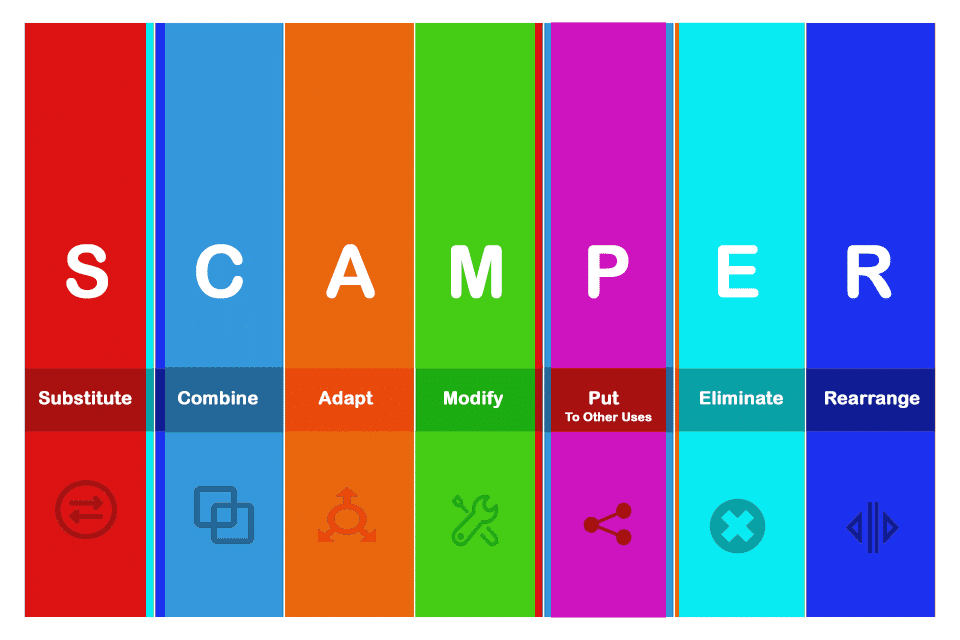What is the Headstand Technique?
Table of Contents: Definition – Procedure – Advantages – Challenges – Tips – Download – Notes
Smartpedia: The headstand technique is a brainstorming format in which questions to be answered are formulated negatively and consolidated answers are reversed into positives.
Headstand technique – finding ideas with a negative question
The headstand technique is a creative problem-solving method that is used particularly in the field of idea generation and innovation management. The special thing about this method is the reversal of the question to be answered. Instead of a neutral or even positively formulated question, the question is formulated negatively and thus ‘turned on its head’. The collected answers are then consolidated and reversed to positive.
There are various alternative names for the upside-down technique: Reversal technique, flip-flop technique or provocation technique. Some publications also refer to it as the headstand method, inversion method, etc. Regardless of the favoured name, it is a brainstorming format for solving problems or finding ideas.
Example: How do we design the newsletter sign-up form so that it is sure to scare away any prospective customer?
Answers: It should have many mandatory fields so that we ask for everything we always wanted to know in addition to the email address. It is also very useful to divide queries over several pages, because once the prospect has provided some information, he won’t mind answering more questions. Ideally, he should navigate between fields by mouse click and not by tabulator; this gives him more time to think. Auto-complete should also be deactivated.
Consolidation and reversal into the positive: Our online form for newsletter registration consists of a single field in which the email address is entered.
Procedure of the headstand technique
The headstand technique follows a clear sequence with
- preparation,
- implementation with idea generation and idea evaluation, and
- follow-up.
At the beginning, the brainstorming rules, the process and the timebox should be discussed and agreed upon. This is followed by the presentation of the problem or the question to be answered by the facilitator. However, as usual, it is not about achieving but losing. It is not about satisfaction but dissatisfaction, not about success but failure. Accordingly, the moderator formulates the question negatively:
- “What do we have to do to make the new advertising campaign fail?”
- “How do we drive prototyping safely to the wall?”
- “How can we hinder the onboarding of new employees?”
Together, answers to the question, the problem to be solved or the idea to be found are sought and documented. The brainstorming is followed by the joint idea evaluation. For this purpose, the collected answers are consolidated and turned into positive ones. The goal in the headstand technique is reached when a list of ideas has been compiled, ideally with the best of them being realised. The idea evaluation should also be limited with a timebox.
In the follow-up, for example, ROTI feedback could provide information on how useful the participants found the exchange and what possibilities for improvement they see for a future exchange.
Advantages of the headstand technique
The headstand technique offers a number of significant advantages over traditional brainstorming that make it a particularly effective method for creative problem solving. One decisive advantage is that the reverse formulation breaks up established thought patterns. As a result, participants are forced to break out of their usual way of thinking and gain new, unexpected insights that might be overlooked in a traditional brainstorming session. This technique encourages participants to look at problems from a completely new perspective and thereby find creative and innovative solutions.
Another advantage of the headstand technique is its ability to promote freer and more associative brainstorming. While classic brainstorming often involves unconsciously evaluating answers, the headstand technique creates an atmosphere in which unusual and unconventional ideas are welcome. The playful reversal of the problem encourages participants to be creative and to express even supposedly absurd ideas. This unbiased approach not only encourages greater participation, especially from introverted employees, but also increases the quality of the solutions found. By eliminating the immediate evaluation of ideas, a more dynamic and open discussion is stimulated, which can lead to deeper and more diverse results.
In addition, the playful approach of the headstand technique helps to ensure that brainstorming is not only productive, but also entertaining and motivating. The creative and often humorous element that the reversal of the problem brings promotes a positive working environment and increases the motivation of the participants. This mix of effectiveness and fun makes the headstand technique a valuable method for teams looking for innovative solutions while strengthening team cohesion and creativity.
Challenges of the headstand technique
A major challenge with the headstand technique is the risk of convergence on existing thought patterns. Although the approach aims to overcome creative blocks, teams, especially experienced or specialised ones, could quickly fall back into familiar patterns when thinking in reverse. As a result, the method may only confirm existing solutions instead of generating truly innovative ideas. There is also a risk of selective reversal. Participants may unconsciously tend to reverse only simple or obvious aspects of the problem, leaving important elements unconsidered and making the method ineffective.
Another challenge is the potential loss of the original problem definition. If the participants concentrate too much on the reversed ideas, the actual problem could lose focus. The process then centres more on the creative inversion than on solving the actual problem, which leads to less relevant results.
Cognitive overload can also be a serious obstacle. The headstand technique requires a high degree of mental flexibility and abstraction, which can be overwhelming for some participants. This can cause frustration and inhibit creativity. Even if the method is successfully applied, the difficulty of transforming the inverted ideas back into usable solutions remains. Bringing the reversed ideas back to the original problem often requires additional creativity and effort, which increases the complexity of the process.
Tips for the headstand method
When using the headstand method, there are some useful tips that can really make a difference in practice:
- It’s useful not to take a blanket approach to the entire problem and turn it into its opposite, but to specifically reverse specific aspects of the problem. For example, instead of ‘How are we making customer satisfaction worse?’ you could ask yourself: ‘How could we frustrate customers so much with our hotline that they never come back?’ This helps to sharpen your focus and come up with more precise and relevant ideas.
- Another tip is to create a negative persona that represents the opposite of your target group. Think about how you would address this negative persona to intentionally create bad experiences. This exercise can help identify hidden needs of your actual target audience and come up with innovative solutions.
- It can also be very helpful to switch perspectives within the team. Have team members swap their usual roles during the reversal. For example, the marketing expert could take on the perspective of a developer and vice versa. This role reversal encourages a break-up of habitual thought patterns and leads to new insights.
- Try asking the team to initially ignore the most obvious ideas. This prevents the discussion from drifting in obvious but less innovative directions and forces participants to think more deeply and take more unconventional approaches.
- Another tip is to involve people who are not normally involved in problem solving, such as employees from other departments or external consultants. These ‘non-experts’ often bring a fresh perspective and challenge assumptions that the team has come to take for granted.
- Rather than immediately turning the ideas back into positives, it might be helpful to gradually and partially reverse them. This can lead to ideas that initially seem absurd suddenly becoming workable through slight adjustments.
By applying these tips, the headstand method can become much more effective in practice and lead to more innovative and relevant solutions.
Download the Ideation Whitepaper for free now.
Everything important about Ideation at a glance.
- Definition and tips from practice
- Idea evaluation
- Methods such as reverse and round robin brainstorming, starbursting, brainwriting, braindumping, Osborn checklist or 1-2-4-All in detail
Knowledge on 17 pages to take away.
Impulse to discuss:
Should the headstand technique aka flip-flop technique aka inversion technique be included in the Liberating Structures as a brainstorming format?
Notes:
If you like the article or would like to discuss it, please feel free to share it in your network. And if you have any comments, please do not hesitate to send us a message.
Here you will find additional information from our Smartpedia section:




